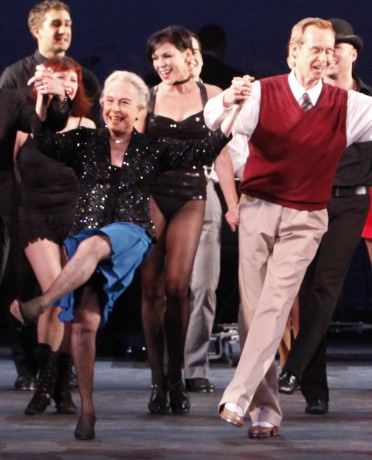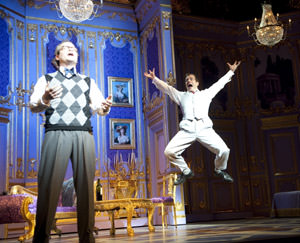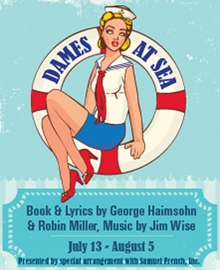When it was announced that Randy Skinner was coming to Infinity Theatre Company this summer to helm a new production of Dames at Sea – I jumped at the chance to talk to Randy about directing and choreographing this wonderful musical.
Joel: How did you get involved with Directing Dames at Sea at Infinity Theatre Company? Have you directed it before?

Randy: Alan and Anna Ostroff were talking with their casting director, Michael Cassara, and they were wondering if they could get one of my assistants to come and work on Dames At Sea, thinking I might not have the time or interest. I knew Michael when he was a student at Otterbein College where I teach on occasion, and he said, “why not ask Randy himself and see what he says?” So Michael called me and told me about the project, the theater, and what Alan and Anna were trying to do in Annapolis with Infinity Theatre and I said, “yes.” I really liked their goals and how they are going about achieving them. They are a terrific couple and have passion and business sense, a combination you need for success. I’ve never been to Annapolis and they told me it was a really great city. Plus I love Dames At Sea. I have directed and choreographed the show and also played the roles of Dick and Lucky several times in my career.
A lot of people know Anything Goes but not Dames at Sea. Tell us about the history of the show and what it’s about. Is it similar in any way to Anything Goes and what’s different about it?
Dames is a wonderful show with a very tuneful score and a fun script that is an homage to all of the Busby Berkeley films from the 1930s. And it has lots of tap dancing which audiences always love. It was originally produced off off-Broadway in 1966 and then moved to off-Broadway in 1968, both productions with newcomer Bernadette Peters. There was also a London production, an off-Broadway revival, and of course, many regional theaters have done it. But like many shows from the past, there are now generations that have not seen this little gem. So it will be great fun to introduce the show to new audiences and remind people who do know the show how special it is. It follows the plot of the movie 42nd Street where the leading lady can’t go on and the young ingenue takes over and saves the show. Anyone who knows either the film or the stage musical will recognize the story line. The only real similarity between Dames and Anything Goes is the period the shows are set in. Both take place in the 1930’s and both involve a ship as part of the setting.
Introduce us to the cast and tell us about the characters they are playing.
Kristie Kerwin is playing “Mona” who is the leading lady of the show within the show. She is temperamental, always goes after what she wants and has an eye out for “Dick,” who is played by Eric Huffman. Dick is a sailor but just happens to be a fantastic songwriter. “Lucky” is Dick’s fellow sailor and pal and he is played by Cody Davis. Lucky loves “Joan” who is played by Darien Crago. Joan is a chorus girl and she wants a wedding ring from Lucky, but so far Lucky hasn’t come through. Megan Kelley plays our ingenue “Ruby” who is right off the bus from Centerville, Utah, hoping to make it in the big city of New York. And to complete our cast, Erick Buckley plays the dual roles of “Hennesey,” the stage manager of the theater, and the “Captain” of the ship where Dick and Lucky are stationed. You can definitely say that Ruby, Dick, and Joan are based on Ruby Keeler, Dick Powell, and Joan Blondell.
Have you worked with any of the cast and designers before?
Everyone connected to the Infinity production is new to me except for Kristie Kerwin and Megan Kelley. The two of them have both danced in Irving Berlin’s White Christmas and they are wonderful talents. It will be really nice for me to meet new people through this show and get to know new talent.
How would you describe your style of directing?
Well, I tend to go for the truth of the situation, even in a light-hearted musical. Sometimes shows like Dames At Sea, 42nd Street, and The Boy Friend to name several, are approached with the idea of “sending them up.” By that I mean hitting the humor in a way that lets the audience know that we as the players know we are making an obvious joke about the plot and characters. I like to stress the underlying innocence and truth of the characters so the humor comes through in a more natural way – letting the audience discover the fun instead of hitting them over their heads with it.
What are some of the challenges and the benefits of staging and choreographing the show in the Infinity Theatre space?

Every theater has its own unique challenges since very few theaters have unlimited stage space, especially when you add set pieces. It’s my job to assess the reality of the stage dimensions and then have many conversations with the set designer and express what I need for the dancing. With a cast of six, it’s not too difficult to make it all work. It’s much trickier when you are dealing with a musical that has a large dancing ensemble. Dames is going to work really well in the Infinity Theatre and the audiences will feel very close to the show since it is not a large theater.
How would you describe your choreography for Dames at Sea? What number was your favorite to choreograph, and which one was the most challenging?
Dames At Sea offers the opportunity for some really fun styles of dancing. The three big tap numbers in the show are “Wall Street,” “Choo Choo Honeymoon,” and “Star Tar.” I really don’t have a favorite with Dames because I like the entire score so much and every song is a winner. I will say that audiences always respond to tapping. I think we all respond to rhythm. Tap dancing is not only visual, but is also auditory. It’s like when the big bands from the 30’s and 40’s had such powerful drummers and featured them. I’ve always said most people love hearing drums and also good tapping.
You choreographed the revival of 42nd Street in 2001, which I saw twice and enjoyed very much. But your involvement with this show began with the original production. Tell about that, and what did you learn from Gower Champion that you have taken with you when you choreograph and direct musicals?
I assisted Gower Champion on the original Broadway production of 42nd Street in 1980. We began pre-production in February of that year and being in a studio with him for six weeks was an education that you would never get anywhere else. I learned the importance of shaping a musical arc, not just within an individual number but also with the entire production. The overall flow of a show and where the numbers are placed within the story is a very important piece of the puzzle. And I learned the importance of how you begin a show and the very first moments that an audience is going to see. That opening dance number in 42nd Street certainly tells the audience what kind of evening they are going to be seeing. The original 42nd Street was produced by the legendary David Merrick. Working for him for over eight years and traveling the world with him was like getting a PhD in theater studies. I wish we were still in the days when there was one producing name above the title of a show. It made things so much easier. Now you will often see ten to twenty names producing which means the creative team is dealing with that many opinions and suggestions.
You have choreographed several Encores! productions in NYC. Please tell my readers about Encores! and about the shows that you have recently choreographed. What show or shows do you really wish Encores! Would let you direct and choreograph?
I have choreographed five musicals for NY City Center Encores. I most recently did Gentlemen Prefer Blondes starring Megan Hilty who is currently playing one of the leads on the television show Smash. Encores shows are very special events in New York City in that they only play for one week, they are mounted in ten rehearsal days, and you get the best of the best to work on them. Originally they were staged concerts with the cast reading from the script and had very little staging or dancing. But over the years, the shows have expanded so now they are fully staged with blocking and all dance numbers are fully choreographed. There are set pieces and costumes. You can imagine the pressure of putting a show up so quickly and facing New York audiences and critics. But somehow it all gets done and everyone works their tails off to get to opening night. The energy and focus are tremendous when you are working this quickly and intensely. And to hear the scores played by a twenty-five piece orchestra in full view of the audience is something that you never experience unless you go to the opera or philharmonic. I’m always interested in learning the next season’s choice of shows. So far, I’ve gotten to do some of the big period dance musicals that they’ve selected. So maybe if another one of those titles comes up, I’ll be getting a call.
When did you first get the theatre bug and what was the first show you directed and choreographed?
I was put in dance class at age four. I’m from Columbus, Ohio and that is where all of my family still live. My parents were always really wise in finding the next teacher when they felt it was time for me to move forward. I obviously took to it and wanted to keep doing it, so I performed in all of the school musicals and plays. I started to choreograph at Ohio State University, and funny enough, one of the first shows I staged was Dames At Sea. I came to New York with only performing on my mind, but after working on the original 42nd Street on Broadway, the door opened to directing and choreographing. I went along with that and started working on the creative side, too. I learned that I liked doing it all, including teaching which is what my degree is in, so wearing many hats suits me.
Who were some of your influences?

I would say my main influence and inspiration have come from film. Watching movies was a big part of my upbringing and I remember as a young guy really being captivated by the Fred and Ginger musicals. There was just something about the two of them that I responded to. I have been very fortunate to dance with and for some of the great stars from the musical films. It was thrilling to be able to get to know people such as Ginger Rogers, Ann Miller, and Gower and Marge Champion, just to name a few. Their work lives on in a way that live theater does not, since film is preserved for all time. And it is all so accessible today on dvds and youtube videos. I’m always encouraging my dancers to immerse themselves in these incredible performances. It really is how one learns style, period, and nuance. Of course, their careers were groomed by the studio system so they really had the best of everything working to create great vehicles for them. The theater used to be more like that too, when shows would be written for theater personalities like Ethel Merman and Gwen Verdon.
The Tony Awards took place two weeks ago. What was some of the best choreography you have seen on Broadway this year and in recent years, and why did you enjoy it?
I’ve mainly been catching up on all of the wonderful and intriguing plays that are now running so I’m way behind with the musicals. I did see Evita and thought Rob Ashford did a wonderful job integrating the dancing and movement into the story. As you know, the evening is totally sung so I think that presents challenges. I also liked what Ronald K. Brown did with The Gershwins’ Porgy and Bess, which is similar to the challenges of Evita in that it is mainly sung with very little dialogue. Finding movement that works for the characters and ensembles is a requirement for these kinds of musicals, but you still have to make it entertaining and energized for the audiences of today. I thought both guys did this extremely well. I wish Mr. Brown had gotten a Tony nod, but with only four places, there are always worthy people overlooked.
You worked on musical version of Lend Me a Tenor in London. Was Ken Ludwig involved and what’s happening with the show? What was the audience and critical response to it?

I spent a year off and on working on Lend Me A Tenor with the various workshops, out of town tryout in Plymouth, and the West End transfer. Ken was not a part of creating the musical. Everywhere we did the show the audiences loved it. Ken’s play is very funny so the source material is really strong and the score really captures the flavor of the 1930s. We got very respectable reviews in London and the audiences rose to their feet nearly every night which is unheard of in London. The British do not stand like we do here in America, so it really means something when they do it. Unfortunately, none of this translated to strong ticket sales so they only had a two- month run. I know the producers are working on getting it mounted here in the States. I loved working on it, though it was not particularly a big dance show. But we found some nice moments for dance that people loved seeing.
What is the state of the Broadway musical today?
I think Broadway has become so expensive, both for producers and ticket buyers that we are currently in a situation where the shows that tend to sell the best are ones with star casting. The lay person forgets that what designates a show being a hit is whether it pays back its investment and many shows do not do this, even if they run for well over a year or longer. So I would say it’s all up for grabs. You put up a show that you believe in and hope that yours is one that people pay full price to see. I do know that word of mouth and the internet chatter are very important today in getting your show off to the right start. Opinions get out there really fast in today’s world.
What do you want audiences to take with them after seeing Dames at Sea at Infinity Theatre?
I hope the audience leaves the theater dancing up the aisles and humming the songs. For many people it will be their first exposure to the show. Maybe it will entice some to watch the musical films that the show mirrors. And of course, in these tough economic challenges, it’s always a nice diversion to see a musical and escape for a while.
Dames at Sea plays from July 13 – August 5, 2012 at Infinity Theatre Company at The CTA Theatre Complex – 1661 Bay Head Road, in Annapolis, Maryland. Performances are Thursdays at 2 pm and 7 pm; Fridays at 8pm; Saturdays at 8pm and Sundays at 2 pm. Purchase tickets here. Here are directions.





